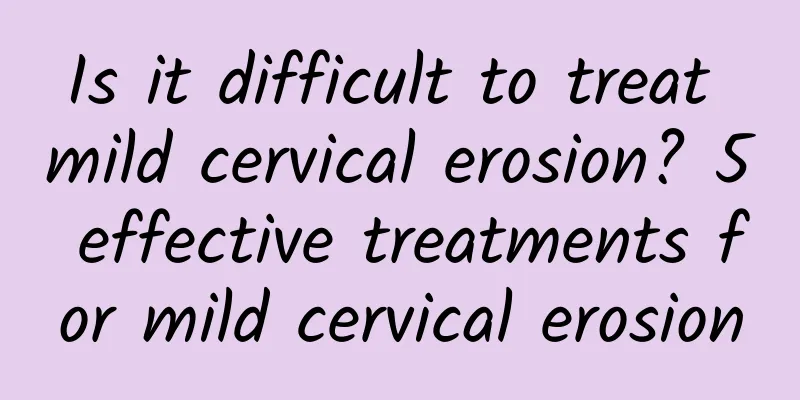What causes cervical erosion?

|
Cervical erosion is mainly caused by physiological changes or inflammatory stimulation of cervical epithelial cells. It is not a true "erosion" but a common gynecological phenomenon. Its causes include changes in hormone levels, chronic inflammation, infection, etc. The treatment method should be selected according to the specific cause, including drugs, physical therapy or surgical intervention. 1. Changes in hormone levels: When women are in puberty, pregnancy, or use oral contraceptives, their estrogen levels increase, which may cause the cervical columnar epithelium to migrate outward, forming an appearance of "erosion". This situation usually does not require special treatment, and regular check-ups are sufficient. If accompanied by discomfort, you may consider using estrogen regulating drugs such as estradiol valerate tablets, ethinyl estradiol cyproterone acetate tablets, etc. 2. Chronic inflammation: Long-term chronic cervicitis is one of the common causes of cervical erosion. Inflammatory stimulation causes damage to cervical epithelial cells, which manifests as erosion-like changes. Anti-infection treatment is required for inflammation. Commonly used drugs include metronidazole, clindamycin, etc. At the same time, local anti-inflammatory drugs such as compound phellodendron liquid coating and Baofukang suppository can be used in combination. 3. Infection: Human papillomavirus (HPV) infection, mycoplasma or chlamydia infection, etc. may also cause cervical erosion. For HPV infection, interferon gel, Baofukang suppository and other drugs can be used for local treatment. For mycoplasma or chlamydia infection, antibiotics such as azithromycin and doxycycline are required for systemic treatment. 4. Physical therapy: For cervical erosion with obvious symptoms or recurring, physical therapy can be considered. Common methods include laser therapy, cryotherapy and electrocautery. Laser therapy destroys the diseased tissue through high-energy beams, cryotherapy uses low temperatures to cause necrosis of diseased cells, and electrocautery burns the diseased area through electric current. These methods must be performed under the guidance of professional doctors. 5. Surgical treatment: Severe cervical erosion or suspected cancer may require surgical treatment. Common surgical methods include cervical conization, loop electrosurgical excision procedure (LEEP), etc. Cervical conization removes part of the cervical tissue for pathological examination, while LEEP uses a high-frequency electric knife to remove the diseased tissue. The operation must be performed by a professional doctor in a regular hospital. The treatment of cervical erosion needs to be based on the specific cause and condition. It is recommended to be carried out under the guidance of a doctor. At the same time, maintaining good living habits, avoiding unclean sexual behavior, and regular gynecological examinations can help prevent and detect cervical lesions at an early stage. |
<<: What are the symptoms of ectopic pregnancy?
>>: Can I have sex if I have cervicitis? Is it contagious?
Recommend
Cervical erosion recurs after surgery
Many women are affected by cervical erosion, whic...
What are the symptoms of irregular menstruation? You can eat these two kinds of food to regulate irregular menstruation
Irregular menstruation is a common symptom of gyn...
What is the cause of Trichomonas vaginitis?
Trichomonas vaginitis is a common gynecological d...
Good news! Eating chocolate cake for breakfast can help you lose weight
As the saying goes, "A day's plan begins...
Chinese medicine diet therapy can assist in the treatment of adnexitis
One of the key points of TCM treatment of adnexit...
How to cure Bartholinitis?
Bartholinitis is a disease caused by long-term st...
Sashimi contains calorie mines, and "this part" has the highest calories! Nutritionist reveals sashimi calories
A bowl of sashimi rice with a variety of seafood ...
What are the causes of uterine fibroids? Can multiple miscarriages also cause uterine fibroids?
Uterine fibroids, also known as uterine leiomyoma...
What to do with pelvic fluid accumulation after cystectomy
After some surgeries, especially some gynecologic...
Pay attention to the postoperative care of these ectopic pregnancies
Ectopic pregnancy mainly refers to the symptoms t...
More than just thirst quenching! Drinking water during exercise has another important function...
Water is very important to the human body. The av...
What is the difference between miscarriage and ectopic pregnancy? There are 3 major differences
The fundamental difference between miscarriage an...
What medicine can women take to cure cervicitis? Revealing the effective treatment of cervicitis in women
All women will suffer from cervicitis. Cervicitis...
How to deal with irregular menstruation? 3 ways to deal with irregular menstruation
Medicinal diet fights irregular menstruation in w...
Do some exercise to relieve menstrual cramps
Dysmenorrhea is a common gynecological disease. M...









